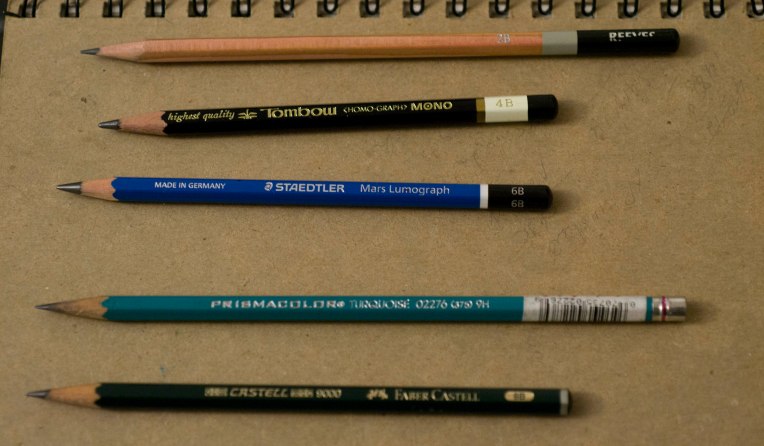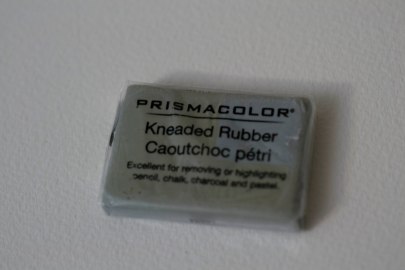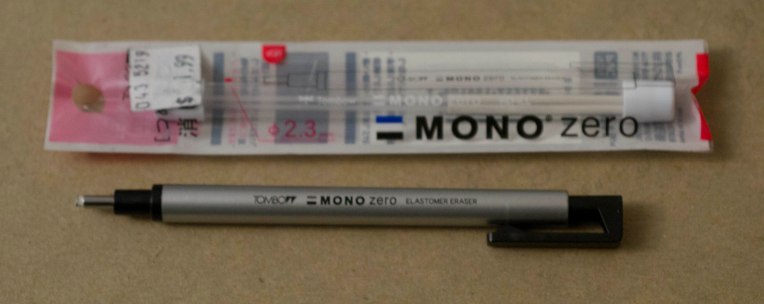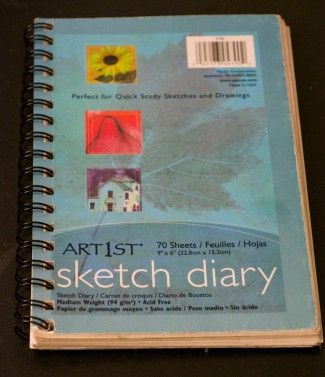When my sister first introduced me to drawing, I was given a charcoal pencil. Later in 2010 when I began drawing again, I picked up a regular mechanical pencil and began drawing on a sketch pad. Since then, I’ve learned a bit about the tools of the trade.
Pencils
Pencils are a major component to drawing. Their quality will affect your outcome. I have seen simple mechanical pencils do amazing work. However, much like a camera, it depends on the artist using them. Where a good photographer can take a wonderful photo with a crummy camera; so it’s true that a good artist can make wonderful art with crummy tools. Imagine how much better the work could be with the correct supplies.
So what pencils should you use?

Graphite pencils come in many different forms, from simple student sets to individual pencils. I started out with Prismacolor graphite pencils. Then someone gave me a set of Pentalic pencils. Now, I have Tombow Mono and Staedtler pencils. Over the years, I have occasionally found a Reeves pencil or two laying around the classroom. I would scoop it up and keep it in my desk if I didn’t know whose it was. For my birthday, I was given a set of Reese pencils. I can’t wait to try them out.
What grades of pencils should you use?
If you purchase a set, it will come with a variety, but if you are purchasing individual pencils, you’ll want to know which ones to get. Isn’t a pencil a pencil? Not really.
Mid-grade pencils
Let’s start with what every student knows–the #2 pencil. Required for those standardized tests, the #2 pencil is what is called HB in art terms. It is the middle ground of pencils. From there, pencils are divided into H (hard) and B (soft) grades. There’s also a F, but I don’t know what it is. It seems to be similar to the HB. The larger the numbers, 2-9, the harder or softer the graphite.
Hard pencils
The H series has a very hard graphite. It takes more pressure to lay down a mark. My favorite H pencil is the 8H or 9H. At first, you may not even realize it has left a mark. It is excellent for those very light values necessary in clouds or snow or a moon.
Soft pencils
The B series is a very soft graphite. It takes hardly any pressure to have a very bold and dark mark. I was impressed with how dark I could get my drawings when I first used the B pencils. Now, I tend to start with the HB, move on to the B, 2B, 4B, 6B, and 8B to create dark values.
Which to purchase
The basic pencils would be 9H, HB (although you could get away with a normal pencil for this), B, 2B, 4B, 6B, and 8B. These will give you a wide range of values in your graphite pencils.
Erasers
Yes, you read that correctly. I often draw as much with an eraser as I do my pencils. Erasers create negative space. They also help keep your work area clean. I have three kinds I use, two are standard and inexpensive, but the third I had to save up money to purchase.
 My absolute go to no matter what is the kneaded eraser. I’m sure there are other brands out there, but I have the Prismacolor brand and it’s very inexpensive and lasts forever! The kneaded eraser is like playing with playdough. You can mold it to whatever shape you want to clean up an area. I use the big blob to keep my edges clean. Whereas, catch light in an eye requires a thin point to just dab to remove any excess graphite.
My absolute go to no matter what is the kneaded eraser. I’m sure there are other brands out there, but I have the Prismacolor brand and it’s very inexpensive and lasts forever! The kneaded eraser is like playing with playdough. You can mold it to whatever shape you want to clean up an area. I use the big blob to keep my edges clean. Whereas, catch light in an eye requires a thin point to just dab to remove any excess graphite.
 My next go to eraser is a Tombow Mono Zero mechanical eraser. It is a very small eraser that comes in a pen style case. I love it for adding highlights to hair, whiskers on animals, or other small areas that need a lighter touch. It also lasts forever! No really. I purchased a set of refills for it over three years ago, thinking I needed to have it on hand because my eraser was getting low. I have yet to open the refill packet!
My next go to eraser is a Tombow Mono Zero mechanical eraser. It is a very small eraser that comes in a pen style case. I love it for adding highlights to hair, whiskers on animals, or other small areas that need a lighter touch. It also lasts forever! No really. I purchased a set of refills for it over three years ago, thinking I needed to have it on hand because my eraser was getting low. I have yet to open the refill packet!
My third eraser I use is an electric eraser. Yes, you read that right, electric. It takes two AAA batteries. At first it took a bit to get use to. A small button on the side vibrates the round rubber eraser back and forth. I found it helped to create a point on the eraser first and then I could create very fine lines, even finer than the Tombow Mono Zero. It works excellently for hair and for colored pencil artwork which is harder to erase.
Paper
Paper is another important factor in your work. A regular copy machine paper will do in a pinch, but if you want art that will last, you’ll want to make the expenditure for archival quality paper. There are several options–sketchbooks or paper.
Sketchbooks
 My first sketchbook was an inexpensive 9″x6″ book from Pacon. I loved the thickness of the paper and didn’t think anything about it until I filled all seventy sheets. Then I purchased another inexpensive sketchbook and realized that not all books are the same. With sketchbooks you can’t tell a book by its cover but by its paper! You want paper that is nice and thick and has a good tooth or weave so the graphite can sink into it. Experiment with different tooth. Another good sketchbook is made by the Bee Paper Company. They have them for different purposes. I have one that is a 9″x9″ and one that’s narrower. The square has thicker tooth and has more of a texture to it. The narrow one has less tooth and is designed for pen.
My first sketchbook was an inexpensive 9″x6″ book from Pacon. I loved the thickness of the paper and didn’t think anything about it until I filled all seventy sheets. Then I purchased another inexpensive sketchbook and realized that not all books are the same. With sketchbooks you can’t tell a book by its cover but by its paper! You want paper that is nice and thick and has a good tooth or weave so the graphite can sink into it. Experiment with different tooth. Another good sketchbook is made by the Bee Paper Company. They have them for different purposes. I have one that is a 9″x9″ and one that’s narrower. The square has thicker tooth and has more of a texture to it. The narrow one has less tooth and is designed for pen.
Art Paper
Art paper comes in a couple of different forms. You can purchase pads of paper or you can purchase single sheets. The single sheets vary in size but are larger than 18″ on one side and are rectangular. I have not purchased single sheets. Instead I purchase the pad of paper and have it on hand at all times. My favorite for working with pencils is Arches Watercolor. I love the feel of the paper. It’s nice and thick and the tooth is such that you can layer lots of graphite and build up deep values. My personal favorite is the hot press; however, I received a cold press pad for Christmas and can’t wait to try it out.
Now, you should have all the information you need to get started. Have fun, experiment, and relax while drawing. Let me see what you do. Don’t be intimidated. My first works were very basic as shown in the Spanish condensed version of the prologue to Dragon’s Future. The more you practice the better you become.

